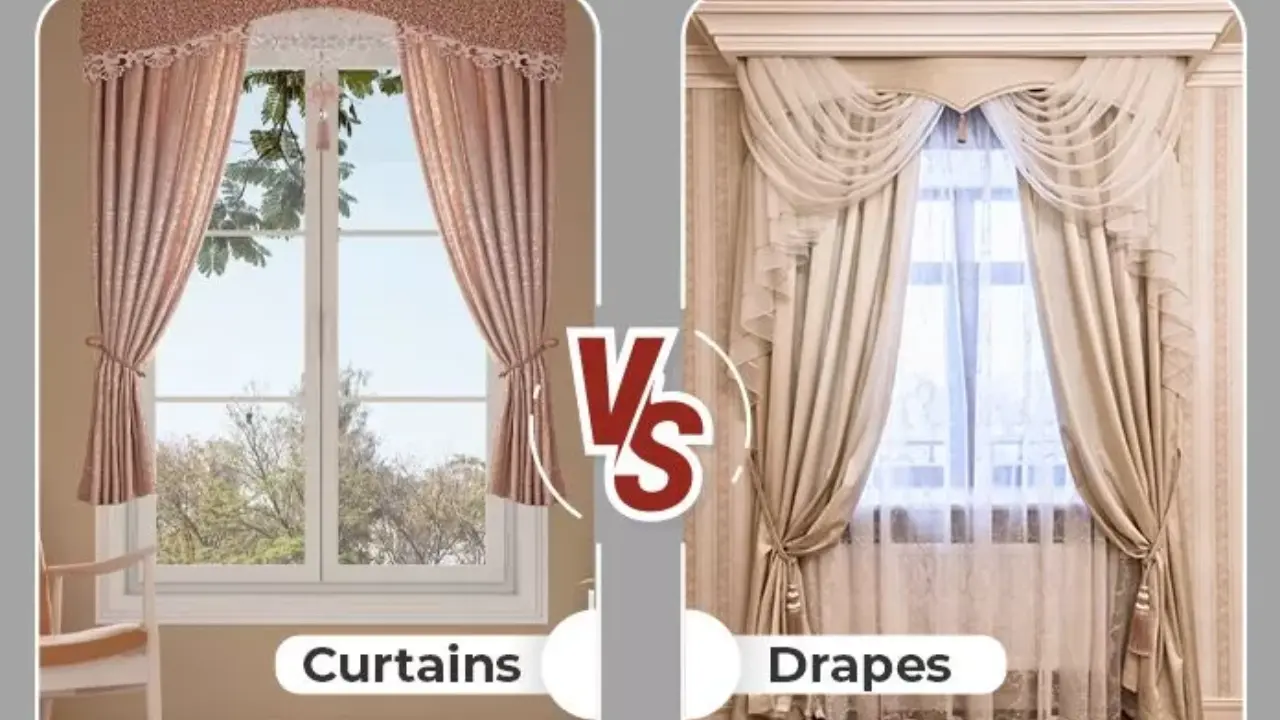The window treatment you choose for your room is very important when it comes to decorating. Window treatments serve practical functions like regulating light, granting privacy, and insulating against heat and cold, in addition to adding aesthetic appeal to your space. Two common window treatment options are drapes vs. curtains, but how do you choose which one is best for your space? In this article, we will explore the drapes vs. curtains and provide you with valuable insights to help you make an informed decision.
Understanding Drapes vs. Curtains
Fabric, length, lining, and overall purpose make drapes and curtains distinct from one another as window treatments. Curtains come in a variety of sizes and are made of lighter materials than drapes, which are floor-length and made of heavy, thick fabrics. Curtains are more common in informal or casual spaces, while drapes are more suitable for formal settings.
Differences in Fabric and Texture
Drapes typically have a rich and elegant appearance because they are made of expensive materials like silk, velvet, or brocade. In addition to adding a touch of luxury to your space, these heavy fabrics have excellent light-blocking and insulation qualities. Contrarily, curtains come in various materials like cotton, linen, polyester, and sheer fabrics. Curtains give off a lighter, airier vibe and are perfect for rooms where you want to let more natural light in.
Light Control and Privacy
Drapes are a great option if privacy and light control are important to you. Their thick fabrics and thick lining enable you to completely block out sunlight when required. Additionally, compared to curtains, drapes offer a higher level of privacy. Contrarily, depending on the fabric picked, curtains offer varying degrees of light filtration. For example, sheer curtains provide privacy during the day and permit diffused light to enter.
Insulation and Energy Efficiency
Because of their heavy weight and lining, drapes perform better than curtains in terms of insulation and energy efficiency. By reducing heat transfer through windows, the thick fabrics of drapes help to keep your room warmer in the winter and cooler in the summer. If saving energy is important to you, buying drapes can help you spend less on heating and cooling. However, if you choose thicker materials or add a thermal lining, curtains can still offer some insulation benefits.
Design and Style
You can enhance the decor of your room and produce a unified look by choosing from a wide variety of designs, patterns, and colors for both drapes and curtains. Drapes are a great option for formal settings like dining rooms or master bedrooms because they frequently have elaborate details like pleats, tassels, and decorative hardware. However, curtains can be quickly changed out to update a room’s appearance and offer greater style versatility.
Maintenance and Care
Curtains usually require less maintenance than drapes. You can machine-wash or quickly spot-clean most curtains, making them a convenient option for dusty or frequently cleaned rooms. Drapes often need expert cleaning or delicate handling because their heavier fabrics and intricate details can affect their quality and appearance.
Cost Considerations
Fabric quality, size, and customization options are some variables that can significantly affect the price of drapes and curtains. Drapes usually cost more than curtains because they use opulent materials and often need professional installation. On the other hand, curtains offer a more affordable option without compromising design or usability.
Factors to Consider When Choosing
Take into account the following factors when choosing between drapes and curtains:
- Determine whether you want a formal, elegant look or a more relaxed, casual atmosphere for the room’s function and atmosphere.
- Determine the level of privacy and light control you require in the space.
- Energy Efficiency: Take into account your desire to increase insulation and energy efficiency as well as the climate.
- Style and Design: Choose window coverings that go well with the decor in your room and improve its overall appearance.
- Care and Maintenance: Choose the amount of maintenance you are willing to perform.
Tips for Choosing the Right Window Treatment
- Take into account the room’s overall design and atmosphere.
- Establish the required level of privacy and light control.
- Remember to take your windows’ size and shape into account.
- Try out various fabric colors and textures.
- Obtain advice from a specialist if necessary.
Conclusion
Your personal preferences, the needs of the room, and your budget will determine which window treatment you should use. Drapes are perfect for formal settings because they add elegance, control light, and provide insulation. Contrarily, curtains are more adaptable, come in a variety of styles, and are a more affordable choice. To find the ideal window treatment that will improve the aesthetics and comfort of your space, take into account the particular requirements of your room and strike a balance between functionality and style.
FAQs
Are drapes and curtains interchangeable terms?
While drapes and curtains are often used interchangeably, they have distinct differences in terms of fabric, length, and overall functionality.
Can I install drapes or curtains without professional help?
Yes, installing drapes or curtains can be a DIY project. However, professional assistance may ensure proper installation if you’re unsure or dealing with complex window treatments.
How often should I clean my drapes or curtains?
The frequency of cleaning depends on factors such as dust accumulation and exposure to smoke or pet dander. Generally, it’s recommended to clean drapes and curtains every 6 to 12 months.

